European banks are set for a better earnings season as bad loan payouts stabilize

With European banks gearing up to report third-quarter earnings as they look to continue a fragile recovery, analysts are expecting sharp reductions in loan loss provisions to drive a fragile stabilization.
Across the pan-European Stoxx 600 index, aggregate third-quarter earnings are expected to decrease 36.7% from the same period in 2019, according to Refinitiv, with revenues declining 12.1% on an annual basis.
The banks specifically are expected to post an aggregate earnings contraction of 46.5% on an annual basis, compared to -38.8% for the overall financial sector.
“Within the banks sub-industry group, Lloyds Bank, HSBC, Barclays, Unicredit, Intesa Sanpaolo, and ING Groep have the largest impact towards the aggregate growth rate,” Refinitiv Senior Research Analyst Tajinder Dhillon noted.
Barclays, which reports on Friday, is expected to report a contraction in annual third-quarter earnings of 79.8%, while HSBC‘s is projected at -55.6% and Lloyds‘ at -90.9%, according to Refinitiv data.
Elsewhere, Deutsche Bank is seen posting a 67.7% growth in third-quarter earnings, having reported a net loss of 832 million euros ($924 million) for the same period last year during a mass restructuring.
Santander is expected to post a 200% spike in earnings, having reported a 75% annual profit drop in the third quarter of 2019, fueled by charges of 1.63 billion euros relating mostly to a goodwill impairment in the U.K.
Loan book provisions
After setting aside $15.3 billion of loan book provisions in the first quarter and a further $18.4 billion in the second, Wall Street giants JPMorgan Chase and Citigroup kicked off U.S. earnings season by allocating just $2.9 billion between them in the third quarter. This meant their combined net income more than doubled from the second to the third quarter.
“That offers some hope that the U.S. economy is through the worst and investors in the U.K.’s biggest lenders will be able to provide similar cheer about their target markets,” AJ Bell Investment Director Russ Mould said in a note last week.
Barclays, HSBC, Lloyds, NatWest and Standard Chartered wrote down their loan books by £7.5 billion ($9.7 billion) in the first quarter and £10.6 billion in the second, Mould pointed out. The latter was the highest charge since the second quarter of 2010, as their aggregate first-half pre-tax profit plummeted by 77% year-on-year.
“A reduction in bad loans after what could have been a particularly conservative approach to the first half would help profits from and sentiment toward a sector that has been in investors’ doghouse,” he added.
Mould suggested the reason that Wall Street banks’ share prices did not climb materially on the back of the third-quarter results was because loan loss provisions were only part of the uphill struggle for lenders; another key factor is the consistent compression of net interest margins.
Net interest margin is a measure of the difference between the amount of interest income generated by a bank and the amount of interest it pays out to its depositors. Loan loss provisions are an amount set aside by a bank to account for expected nonpayment of loans it has granted to businesses or consumers.
In a note to investors last week, Barclays banking analysts echoed these expectations, suggesting that third-quarter earnings reports will not include substantial impairment charges and that management will likely wait until year-end to update banks’ macroeconomic assumptions.
“Additionally, we are yet to see a significant increase in corporate defaults, with government support schemes largely protecting businesses to date,” Barclays Head of European Banks Equity Research Amit Goel said.
“However, we expect there to be intense examination for signs of underlying stress in loan books, especially as many support schemes begin to taper.”
Low bar, but murky outlook
The Stoxx 600 Banks index is down more than 42% since the turn of the year, but Barclays has suggested that given the banks’ current valuations, the risks from a second wave of coronavirus infections are “overly discounted.”
“In the coming results season, we think focus will be on the revenue recovery post-lockdown, particularly with a view to 2021 income and the implied run-rate going forward,” Goel said.
Barclays expects management commentary to provide a helpful indication of conditions heading into the final quarter of the year.
Alongside the significant reduction in impairment charges, Barclays suggested that the strength of recovery will be on investors’ radar as a basis for resetting revenue estimates into 2021. However, analysts believe the sustainability of this recovery will likely come under scrutiny given the reintroduction of Covid-19 restrictions throughout Europe.
Trading revenues, which were buoyant across the banking sector in the second quarter on the back of a surge in volumes, are expected to somewhat normalize in the third while remaining up on a year-on-year basis.
“Although there have not been any changes to the regulatory intervention preventing banks from paying dividends in 2020, the potential for restarting dividends remains a point of focus for banks,” Goel said in the note.
“Given the proximity to year-end and general strength of capital across the sector (albeit incorporating capital reliefs) we expect the topic to be broached with renewed vigor at Q3 results.”
Goel’s team recently identified their top stock picks within the sector.
With downside risks from Covid-19 remaining heightened in the fourth quarter, but governments appearing better prepared than during the first wave of the pandemic, Barclays expects the banking sector to focus primarily on cost-cutting efforts and consolidation.




